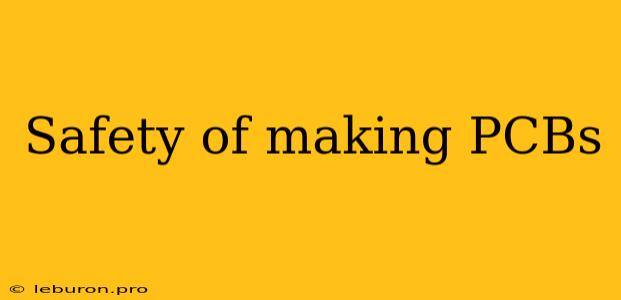The creation of printed circuit boards (PCBs) is a fundamental aspect of modern electronics, enabling the intricate connections required for various devices. While the process offers immense technological advantages, it's crucial to prioritize safety throughout the manufacturing and handling stages. The potential risks associated with PCB fabrication necessitate a comprehensive understanding of safety measures to ensure the well-being of individuals involved. This article will delve into the various safety considerations that are paramount in the safety of making PCBs, addressing potential hazards and outlining best practices to mitigate risks.
Safety Hazards in PCB Manufacturing
The PCB manufacturing process involves several steps, each presenting unique safety challenges. These hazards can range from chemical exposure to electrical shock, emphasizing the need for stringent safety protocols.
Chemical Exposure
PCB fabrication often involves the use of hazardous chemicals, such as:
- Etchants: These chemicals, typically copper chloride or ferric chloride, are used to remove unwanted copper from the PCB. They are highly corrosive and can cause severe burns upon skin contact.
- Solder: Lead-based solder is still used in some applications, posing a risk of lead poisoning through inhalation or ingestion.
- Cleaning agents: Solvents used for cleaning PCBs can be flammable and toxic, requiring proper ventilation and handling.
- Resists: Photoresists used in photolithography processes can release volatile organic compounds (VOCs) that can be harmful to health.
Electrical Hazards
- High voltage: During the etching process, high voltages can be used, posing an electrocution risk.
- Static electricity: The accumulation of static charges can damage sensitive electronic components and cause electrical shocks.
Other Hazards
- Dust and fumes: The drilling and milling processes generate dust and fumes that can irritate the respiratory system and cause health problems.
- Fire hazards: Flammable materials such as solvents and resins used in PCB manufacturing increase the risk of fire.
- Ergonomic hazards: Repetitive tasks and awkward postures can lead to musculoskeletal injuries.
Safety Measures for PCB Manufacturing
To ensure the safety of workers and the environment, it is essential to implement comprehensive safety measures at all stages of PCB fabrication.
Personal Protective Equipment (PPE)
- Gloves: Wearing appropriate gloves is essential to protect against chemical exposure. Different types of gloves are available for different chemicals, such as nitrile gloves for acids and PVC gloves for solvents.
- Eye protection: Safety goggles or face shields should be worn to protect the eyes from splashes or fumes.
- Respiratory protection: Respirators are required to protect against dust, fumes, and vapors.
- Protective clothing: Lab coats, aprons, and coveralls provide additional protection against chemical splashes and spills.
Environmental Controls
- Ventilation: Proper ventilation systems are crucial to remove hazardous fumes and dust from the workspace.
- Waste disposal: Chemicals and other wastes generated during PCB fabrication must be disposed of properly to prevent environmental contamination.
- Emergency showers and eyewashes: These facilities should be readily accessible in case of chemical splashes or spills.
Process Control
- Chemical handling: Chemicals should be handled carefully and stored in appropriate containers.
- Equipment maintenance: Regular maintenance of equipment reduces the risk of malfunctions and accidents.
- Training and education: All workers involved in PCB manufacturing should receive comprehensive training on safety procedures and the hazards associated with the process.
Safety During PCB Handling
Even after the PCB fabrication process is complete, there are still safety concerns associated with handling the finished boards.
- Static discharge: PCBs are susceptible to damage from static electricity. Proper grounding and anti-static packaging are essential for protecting the boards from static discharge.
- Soldering: Soldering involves the use of hot irons and lead-based solder, requiring appropriate precautions to prevent burns and lead exposure.
- Component handling: Components can be fragile and require careful handling to avoid damage.
Conclusion
Safety in PCB manufacturing is paramount, and it is essential to implement comprehensive measures to mitigate risks. By following safety guidelines, utilizing appropriate PPE, and ensuring proper process control, individuals can contribute to a safe and healthy working environment. The safety of making PCBs is a shared responsibility, and continuous awareness and vigilance are crucial to prevent accidents and protect the well-being of all involved.
